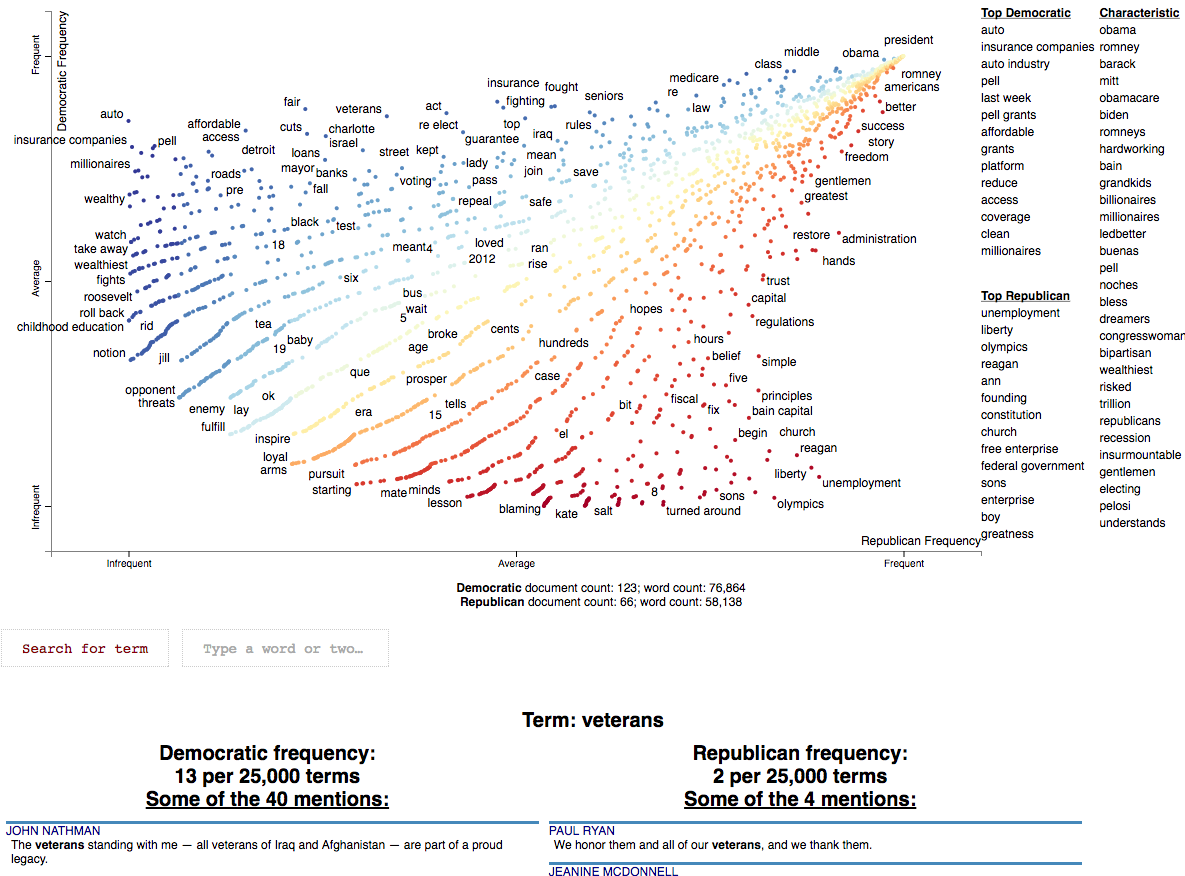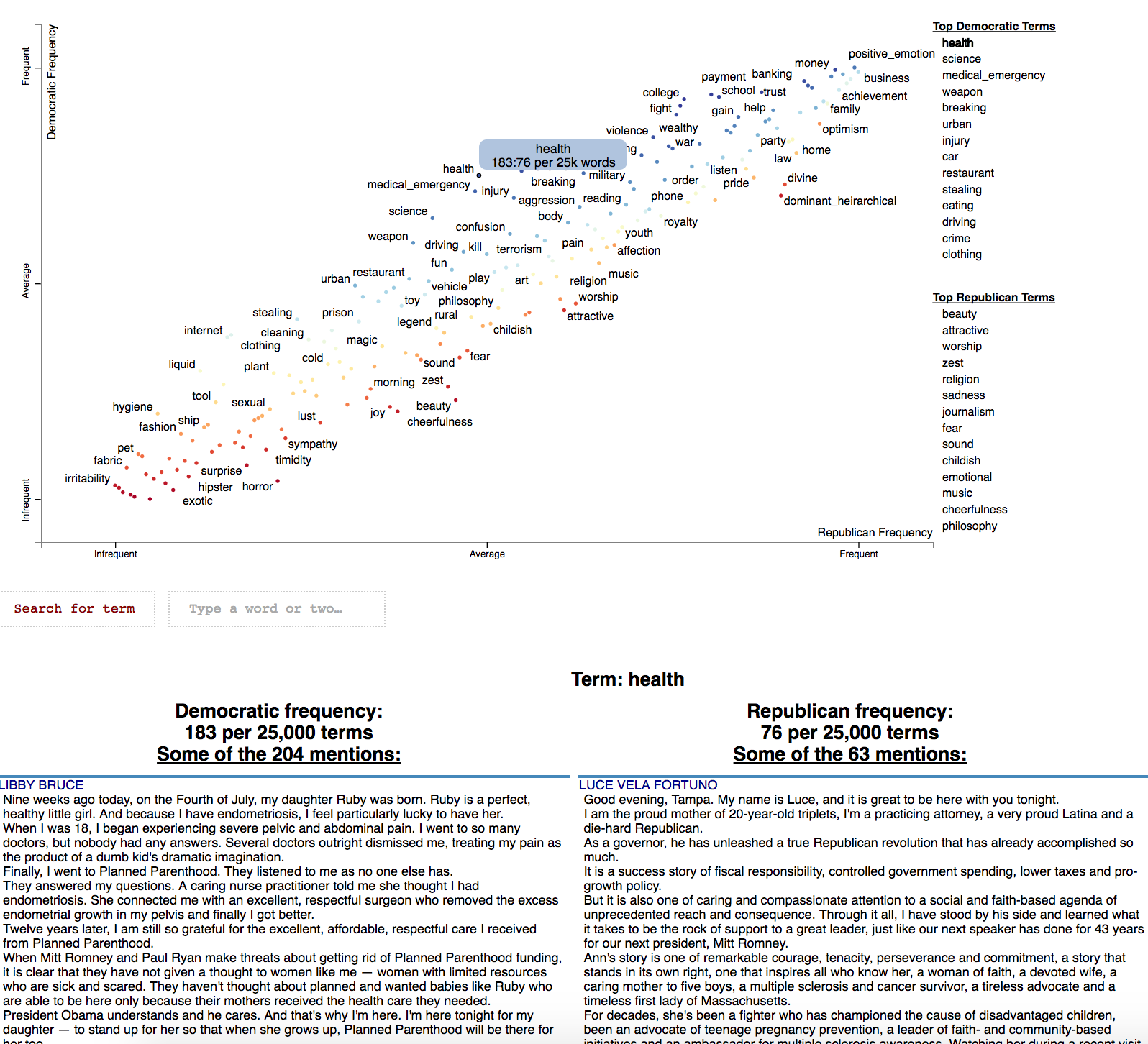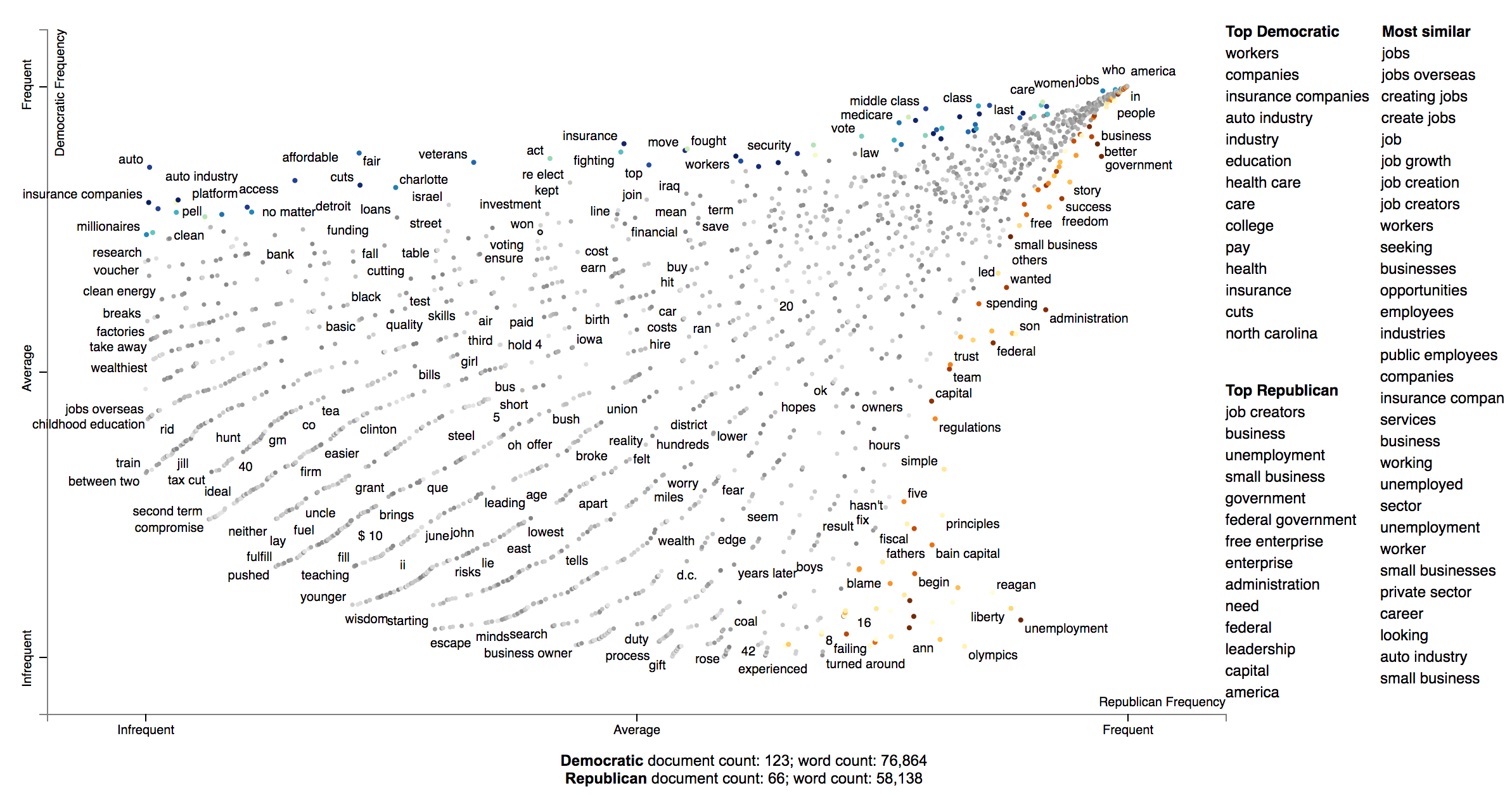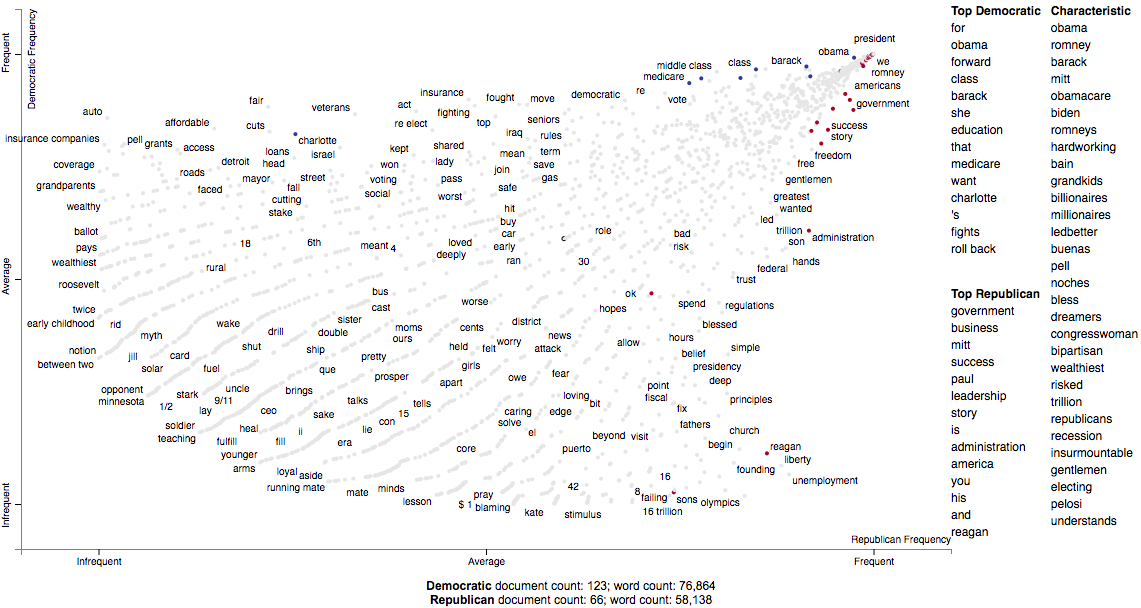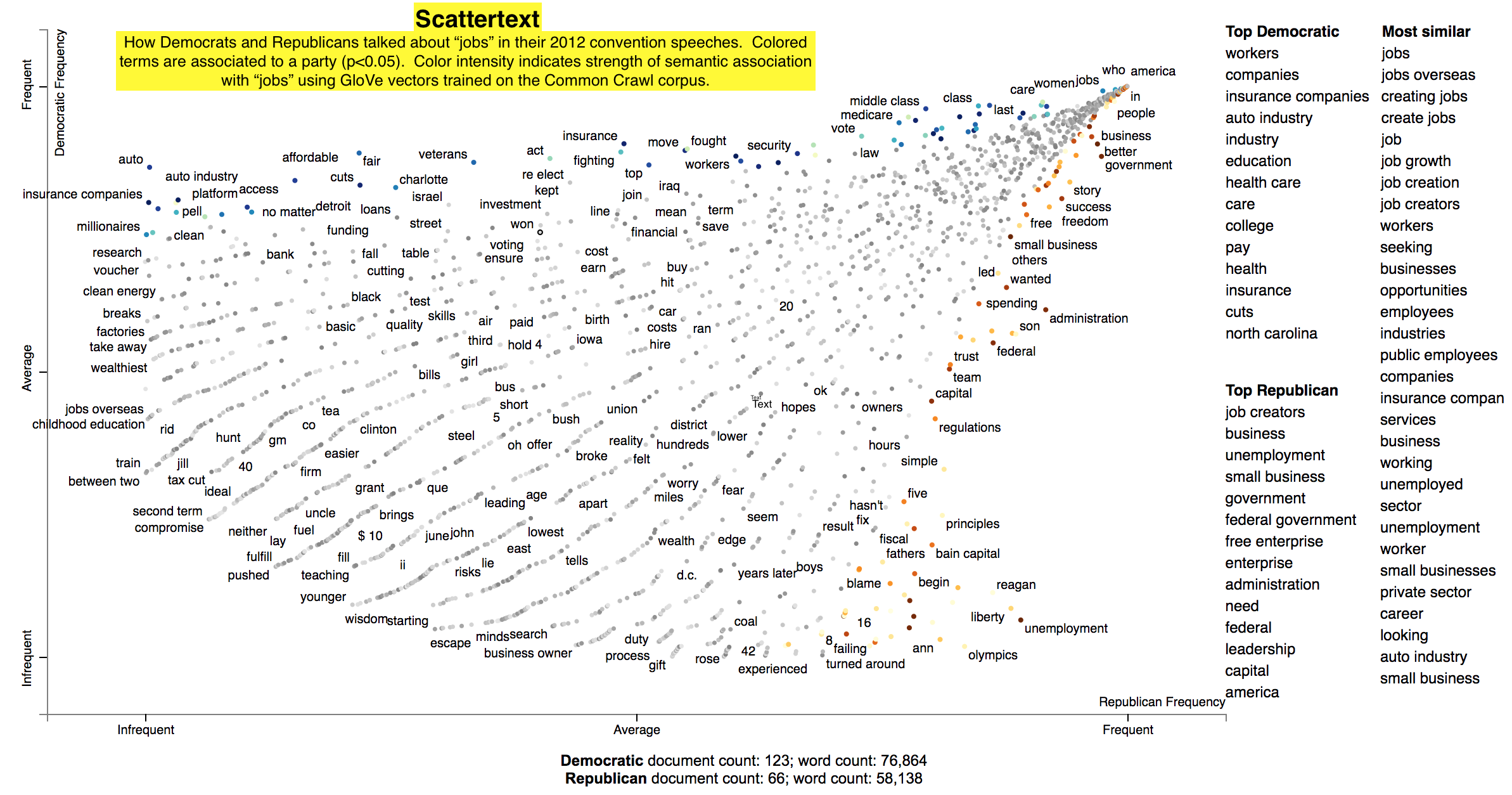Table of Contents
- Installation
- Citation
- Overview
- Tutorial
- Advanced Uses
- Examples
- A note on chart layout
- Presentations on Scattertext
- What's new
- Sources
A tool for finding distinguishing terms in small-to-medium-sized corpora, and presenting them in a sexy, interactive scatter plot with non-overlapping term labels. Exploratory data analysis just got more fun.
Feel free to use the Gitter community gitter.im/scattertext for help or to discuss the project.
Install Python 3.4.+ I recommend using Anaconda.
$ pip install scattertext && python -m spacy.en.download
If you cannot (or don't want to) install spaCy, substitute nlp = spacy.en.English() lines with
nlp = scattertext.WhitespaceNLP.whitespace_nlp. Note, this is not compatible
with word_similarity_explorer, and the tokenization and sentence boundary detection
capabilities will be low-performance regular expressions. See demo_without_spacy.py
for an example.
Python 2.7 support is experimental. Many things will break.
The HTML outputs look best in Chrome and Safari.
. Proceedings of the 54th Annual Meeting of the Association for Computational Linguistics (ACL): System Demonstrations. 2017.
Link to preprint: arxiv.org/abs/1703.00565
@article{kessler2017scattertext,
author = {Kessler, Jason S.},
title = {Scattertext: a Browser-Based Tool for Visualizing how Corpora Differ},
booktitle = {Proceedings of ACL-2017 System Demonstrations},
year = {2017},
address = {Vancouver, Canada},
publisher = {Association for Computational Linguistics},
}
This is a tool that's intended for visualizing what words and phrases are more characteristic of a category than others.
Consider this example:
Looking at this seem overwhelming. In fact, it's a relatively simple visualization of word use during the 2012 political convention. Each dot corresponds to a word or phrase mentioned by Republicans or Democrats during their conventions. The closer a dot is to the top of the plot, the more frequently it was used by Democrats. The further right a dot, the more that word or phrase was used by Republicans. Words frequently used by both parties, like "of" and "the" and even "Mitt" tend to occur in the upper-right-hand corner. Although very low frequency words have been hidden to preserve computing resources, a word that neither party used, like "giraffe" would be in the bottom-left-hand corner.
The interesting things happen close to the upper-left and lower-right corners. In the upper-left corner, words like "auto" (as in auto bailout) and "millionaires" are frequently used by Democrats but infrequently or never used by Republicans. Likewise, terms frequently used by Republicans and infrequently by Democrats occupy the bottom-right corner. These include "big government" and "olympics", referring to the Salt Lake City Olympics in which Gov. Romney was involved.
Terms are colored by their association. Those that are more associated with Democrats are blue, and those more associated with Republicans red.
Terms (only unigrams for now) that are most characteristic of the both sets of documents are displayed on the far-right of the visualization.
The inspiration for this visualization came from Dataclysm (Rudder, 2014).
Scattertext is designed to help you build these graphs and efficiently label points on them.
The documentation (including this readme) is a work in progress. Please see the quickstart as well as the accompanying Juypter notebooks (like this one), and poking around the code and tests should give you a good idea of how things work.
The library covers some novel and effective term-importance formulas, including Scaled F-Score. See slides 52 to 59 of the Turning Unstructured Content into Kernels of Ideas talk for more details.
While you should learn Python fully use Scattertext, I've put some of the basic functionality in a commandline tool. The tool is installed when you follow the procedure layed out above.
Run $ scattertext --help from the commandline to see the full usage information. Here's a quick example of
how to use vanilla Scattertext on a CSV file. The file needs to have at least two columns,
one containing the text to be analyzed, and another containing the category. In the example CSV below,
the columns are text and party, respectively.
The example below processes the CSV file, and the resulting HTML visualization into cli_demo.html.
Note, the parameter --minimum_term_frequency=8 omit terms that occur less than 8
times, and --regex_parser indicates a simple regular expression parser should
be used in place of spaCy. The flag --one_use_per_doc indicates that term frequency
should be calculated by only counting no more than one occurrence of a term in a document.
$ curl -s https://cdn.rawgit.com/JasonKessler/scattertext/master/scattertext/data/political_data.csv | head -2
party,speaker,text
democrat,BARACK OBAMA,"Thank you. Thank you. Thank you. Thank you so much.Thank you.Thank you so much. Thank you. Thank you very much, everybody. Thank you.
$
$ scattertext --datafile=https://cdn.rawgit.com/JasonKessler/scattertext/master/scattertext/data/political_data.csv \
> --text_column=text --category_column=party --metadata_column=speaker --positive_category=democrat \
> --category_display_name=Democratic --not_category_display_name=Republican --minimum_term_frequency=8 \
> --one_use_per_doc --regex_parser --outputfile=cli_demo.htmlThe following code creates a stand-alone HTML file that analyzes words used by Democrats and Republicans in the 2012 party conventions, and outputs some notable term associations.
First, import Scattertext and spaCy.
>>> import scattertext as st
>>> import spacy
>>> from pprint import pprint
Next, assemble the data you want to analyze into a Pandas data frame. It should have
at least two columns, the text you'd like to analyze, and the category you'd like to
study. Here, the text column contains convention speeches while the party column
contains the party of the speaker. We'll eventually use the speaker column
to label snippets in the visualization.
>>> convention_df = st.SampleCorpora.ConventionData2012.get_data()
>>> convention_df.iloc[0]
party democrat
speaker BARACK OBAMA
text Thank you. Thank you. Thank you. Thank you so ...
Name: 0, dtype: object
Turn the data frame into a Scattertext Corpus to begin analyzing it. To look for differences
in parties, set the category_col parameter to 'party', and use the speeches,
present in the text column, as the texts to analyze by setting the text col
parameter. Finally, pass a spaCy model in to the nlp argument and call build() to construct the corpus.
# Turn it into a Scattertext Corpus
>>> nlp = spacy.en.English()
>>> corpus = st.CorpusFromPandas(convention_df,
... category_col='party',
... text_col='text',
... nlp=nlp).build()
Let's see characteristic terms in the corpus, and terms that are most associated Democrats and Republicans. See slides 52 to 59 of the Turning Unstructured Content ot Kernels of Ideas talk for more details on these approaches.
Here are the terms that differentiate the corpus from a general English corpus.
>>> print(list(corpus.get_scaled_f_scores_vs_background().index[:10]))
['obama',
'romney',
'barack',
'mitt',
'obamacare',
'biden',
'romneys',
'hardworking',
'bailouts',
'autoworkers']
Here are the terms that are most associated with Democrats:
>>> term_freq_df = corpus.get_term_freq_df()
>>> term_freq_df['Democratic Score'] = \
... corpus.get_scaled_f_scores('democrat')
>>> pprint(list(term_freq_df.sort_values(by='Democratic Score',
... ascending=False).index[:10]))
['auto',
'america forward',
'auto industry',
'insurance companies',
'pell',
'last week',
'pell grants',
"women 's",
'platform',
'millionaires']
And Republicans:
>>> term_freq_df['Republican Score'] = \
... corpus.get_scaled_f_scores('republican')
>>> pprint(list(term_freq_df.sort_values(by='Democratic Score',
... ascending=False).index[:10]))
['big government',
"n't build",
'mitt was',
'the constitution',
'he wanted',
'hands that',
'of mitt',
'16 trillion',
'turned around',
'in florida']
Now, let's write the scatter plot a stand-alone HTML file. We'll make the y-axis category "democrat", and name
the category "Democrat" with a capital "D" for presentation
purposes. We'll name the other category "Republican" with a capital "R". All documents in the corpus without
the category "democrat" will be considered Republican. We set the width of the visualization in pixels, and label
each excerpt with the speaker using the metadata parameter. Finally, we write the visualization to an HTML file.
>>> html = st.produce_scattertext_explorer(corpus,
... category='democrat',
... category_name='Democratic',
... not_category_name='Republican',
... width_in_pixels=1000,
... metadata=convention_df['speaker'])
>>> open("Convention-Visualization.html", 'wb').write(html.encode('utf-8'))
Below is what the webpage looks like. Click it and wait a few minutes for the interactive version.
In order to visualize Empath (Fast 2016) topics and categories instead of terms, we'll need to
create a Corpus of extracted topics and categories rather than unigrams and
bigrams. To do so, use the FeatsOnlyFromEmpath feature extractor. See the sourcecode for
examples of how to make your own.
>>> corpus = st.CorpusFromParsedDocuments(convention_df,
... category_col='party',
... feats_from_spacy_doc=st.FeatsFromOnlyEmpath(),
... parsed_col='text').build()
When creating the visualization, pass the use_non_text_features=True argument into
produce_scattertext_explorer. This will instruct it to use the labeled Empath
topics and categories instead of looking for terms. Since the documents returned
when a topic or category label is clicked will be in order of the document-level
category-association strength, setting use_full_doc=True makes sense, unless you have
enormous documents. Otherwise, the first 300 characters will be shown.
>>> html = st.produce_scattertext_explorer(corpus,
... category='democrat',
... category_name='Democratic',
... not_category_name='Republican',
... width_in_pixels=1000,
... metadata=convention_df['speaker'],
... use_non_text_features=True,
... use_full_doc=True)
>>> open("Convention-Visualization-Empath.html", 'wb').write(html.encode('utf-8'))
Word representations have recently become a hot topic in NLP. While lots of work has been done visualizing how terms relate to one another given their scores (e.g., http://projector.tensorflow.org/), none to my knowledge has been done visualizing how we can use these to examine how document categories differ.
In this example given a query term, "jobs", we can see how Republicans and Democrats talk about it differently.
In this configuration of Scattertext, words are colored by their similarity to a query phrase.
This is done using spaCy-provided GloVe word vectors (trained on
the Common Crawl corpus). The cosine distance between vectors is used,
with mean vectors used for phrases.
The calculation of the most similar terms associated with each category is a simple heuristic. First, sets of terms closely associated with a category are found. Second, these terms are ranked based on their similarity to the query, and the top rank terms are displayed to the right of the scatterplot.
A term is considered associated if its p-value is less than 0.05. P-values are determined using Monroe et al. (2008)'s difference in the weighted log-odds-ratios with an uninformative Dirichlet prior. This is the only model-based method discussed in Monroe et al. that does not rely on a large, in-domain background corpus. Since we are scoring bigrams in addition to the unigrams scored by Monroe, the size of the corpus would have to be larger to have high enough bigram counts for proper penalization. This function relies the Dirichlet distribution's parameter alpha, a vector, which is uniformly set to 0.01.
Here is the Scattertext to produce such a visualization.
>>> from scattertext word_similarity_explorer
>>> html = word_similarity_explorer(corpus,
... category='democrat',
... category_name='Democratic',
... not_category_name='Republican',
... target_term='jobs',
... minimum_term_frequency=5,
... pmi_filter_thresold=4,
... width_in_pixels=1000,
... metadata=convention_df['speaker'],
... alpha=0.01,
... max_p_val=0.05,
... save_svg_button=True)
>>> open("Convention-Visualization-Jobs.html", 'wb').write(html.encode('utf-8'))
We can use Scattertext to visualize alternative types of word scores, and ensure that 0 scores are greyed out. Use the sparse_explroer function to acomplish this, and see its source code for more details.
>>> from sklearn.linear_model import Lasso
>>> from scattertext sparse_explorer
>>> html = sparse_explorer(corpus,
... category='democrat',
... category_name='Democratic',
... not_category_name='Republican',
... scores = corpus.get_regression_coefs('democrat', Lasso(max_iter=10000)),
... minimum_term_frequency=5,
... pmi_filter_thresold=4,
... width_in_pixels=1000,
... metadata=convention_df['speaker'])
>>>
open('./Convention-Visualization-Sparse.html', 'wb').write(html.encode('utf-8'))
To how Scattertext can be used for subjectivity lexicon development (and why using log-axis scales are a bad idea) check out the Subjective vs. Objective notebook.
Scattertext can also be used to visualize topic models, analyze how word vectors and categories interact, and understand document classification models. You can see examples of all of these applied to 2016 Presidential Debate transcripts.
We use the task of predicting a movie's revenue from the content of its reviews as an example of tuning Scattertext. See the analysis at Movie Reviews and Revenue.
Cozy: The Collection Synthesizer (Loncaric 2016) was used to help determine which terms could be labeled without overlapping a circle or another label. It automatically built a data structure to efficiently store and query the locations of each circle and labeled term.
The script to build rectangle-holder.js was
fields ax1 : long, ay1 : long, ax2 : long, ay2 : long
assume ax1 < ax2 and ay1 < ay2
query findMatchingRectangles(bx1 : long, by1 : long, bx2 : long, by2 : long)
assume bx1 < bx2 and by1 < by2
ax1 < bx2 and ax2 > bx1 and ay1 < by2 and ay2 > by1
And it was called using
$ python2.7 src/main.py <script file name> --enable-volume-trees \
--js-class RectangleHolder --enable-hamt --enable-arrays --js rectangle_holder.js
-
Turning Unstructured Content into Kernels of Ideas for an introduction to the metrics and algorithms used.
Enhanced the visualization of query-based categorical differences, a.k.a the word_similarity_explorer
function. When run, a plot is produced that contains category associated terms
colored in either red or blue hues, and terms not associated with either class
colored in greyscale and slightly smaller. The intensity of each color indicates
association with the query term. For example:
Some minor bug fixes, and added a minimum_not_category_term_frequency parameter. This fixes a problem with
visualizing imbalanced datasets. It sets a minimum number of times a word that does not appear in the target
category must appear before it is displayed.
Added TermDocMatrix.remove_entity_tags method to remove entity type tags
from the analysis.
Fixed matched snippet not displaying issue #9, and fixed a Python 2 issue
in created a visualization using a ParsedCorpus prepared via CorpusFromParsedDocuments, mentioned
in the latter part of the issue #8 discussion.
Again, Python 2 is supported in experimental mode only.
Corrected example links on this Readme.
Fixed a bug in Issue 8 where the HTML visualization produced by produce_scattertext_html would fail.
Fixed a couple issues that rendered Scattertext broken in Python 2. Chinese processing still does not work.
Note: Use Python 3.4+ if you can.
Fixed links in Readme, and made regex NLP available in CLI.
Added the command line tool, and fixed a bug related to Empath visualizations.
Ability to see how a particular term is discussed differently between categories
through the word_similarity_explorer function.
Specialized mode to view sparse term scores.
Fixed a bug that was caused by repeated values in background unigram counts.
Added true alphabetical term sorting in visualizations.
Added an optional save-as-SVG button.
Addition option of showing characteristic terms (from the full set of documents) being considered.
The option (show_characteristic in produce_scattertext_explorer) is on by default,
but currently unavailable for Chinese. If you know of a good Chinese wordcount list,
please let me know. The algorithm used to produce these is F-Score. See this and the following slide for more details
Added document and word count statistics to main visualization.
Added preliminary support for visualizing Empath (Fast 2016) topics categories instead of emotions. See the tutorial for more information.
Improved term-labeling.
Addition of strip_final_period param to FeatsFromSpacyDoc to deal with spaCy
tokenization of all-caps documents that can leave periods at the end of terms.
I've added support for Chinese, including the ChineseNLP class, which uses a RegExp-based
sentence splitter and Jieba for word
segmentation. To use it, see the demo_chinese.py file. Note that CorpusFromPandas
currently does not support ChineseNLP.
In order for the visualization to work, set the chinese_mode flat to True in
produce_scattertext_explorer.
- 2012 Convention Data: scraped from The New York Times.
- count_1w: Peter Norvig assembled this file (downloaded from norvig.com). See http://norvig.com/ngrams/ for an explanation of how it was gathered from a very large corpus.
- hamlet.txt: William Shakespeare. From shapespeare.mit.edu
- Inspiration for text scatter plots: Rudder, Christian. Dataclysm: Who We Are (When We Think No One's Looking). Random House Incorporated, 2014.
- Loncaric, Calvin. "Cozy: synthesizing collection data structures." Proceedings of the 2016 24th ACM SIGSOFT International Symposium on Foundations of Software Engineering. ACM, 2016.
- Fast, Ethan, Binbin Chen, and Michael S. Bernstein. "Empath: Understanding topic signals in large-scale text." Proceedings of the 2016 CHI Conference on Human Factors in Computing Systems. ACM, 2016.
- Burt L. Monroe, Michael P. Colaresi, and Kevin M. Quinn. 2008. Fightin’ words: Lexical feature selection and evaluation for identifying the content of political conflict. Political Analysis.


